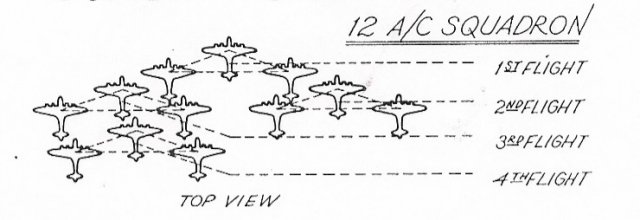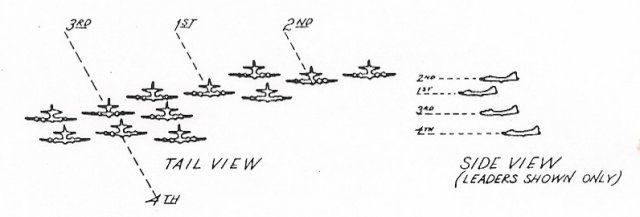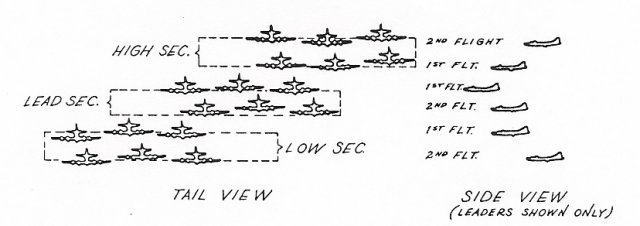 |
Standard Operating Procedure Formations - 12 & 18 Aircraft |
Personnel
Mission Reports
Crew Composition
Intelligence
HEADQUARTERS
303RD BOMBARDMENT GROUP (H)
APO 557, U.S. ARMY
15 October 1944


- FORMATION, 12 AIRCRAFT:
- The standard Squadron formation will consist of 12 aircraft. There will be four flights of three aircraft each, a Lead flight (Number 1 flight), High Flight (Number 2 flight), and a Low Squadron (Number's 3 and 4 flights).
- The Leader of the 2nd Flight flies high (approximately 75 feet) and to the right of the Lead Flight.
- The Leader of the Number 3 flight flies low (approximately 75 feet) and to the left of the Lead Flight.
- The Leader of the Number 4 flight flies low (approximately 75 feet) and slightly to the fight of the Number 3 Flight.
- Wingmen of the Lead Flight flies with Number 2 aircraft slight down and Number 3 aircraft slightly up. They will be forward and far enough out to clear wing tips.
- Wingmen of the Number 2, 3 and 4 Flights will be level and will follow forward and far enough out to clear wing tips.
- If aircraft are available, a 13th aircraft is usually flown with this formation. This aircraft flies in the position of a flight leader behind the Number 2 Flight. He is stacked high and slightly to the left.
- The Leader of the 2nd Flight flies high (approximately 75 feet) and to the right of the Lead Flight.
- To be effective, both offensively and defensively, this formation must be flown as close as safety will permit. When properly flown, the best possible bomb pattern can be obtained. One flight leader, or one wingman out of position can disrupt the effectiveness of the entire pattern. The size of the pattern is also proportionate to the depth of the formation, so it will pay dividends on target hits to keep formation as shallow as possible. In case an aircraft becomes disabled on the bomb run, the pilot should not disrupt his own formation on formations in trail.
- If the Squadron Leader aborts, the Number 3 flight (Number 3 Flight Leader) takes over the Lead.
- The Number 2 flight remains in position.
- The Number 3 flight becomes Number 1 Flight
- The Number 4 flight becomes Number 3 Flight
- Number 2 and 3 aircraft of 1st Flights becomes 1 and 2, Number 4 flight.
- In case of abortion of other aircraft in the formation, aircraft move up from the rear to fill the vacancies.
- RESPONSIBILITIES
- The aircraft commander has definite responsibilities no matter what position he is flying in the formation.
- He is responsible for the condition of his aircraft.
- He is responsible that he himself, as well as his crew members are qualified for combat, physically and mentally.
- It is the aircraft commander's responsibility to keep his aircraft in its proper position.
- Flight Leaders and Section Leaders are responsible that the unit under his control is flown in the correct position.
- The Squadron and Group Leader, in addition to the responsibilities of the aircraft Commander, is also responsible for the two primary objectives of a Bombardment unit.
- The first objective of any bomb force is to bomb the target
- The second objective is to return to base with minimum losses.
- He is responsible for the condition of his aircraft.
- The aircraft commander has definite responsibilities no matter what position he is flying in the formation.


18 AIRCRAFT FOMATION - The standard Squadron formation will consist of 12 aircraft. There will be four flights of three aircraft each, a Lead flight (Number 1 flight), High Flight (Number 2 flight), and a Low Squadron (Number's 3 and 4 flights).
- FORMATION, 18 AIRCRAFT:
- An optional formation flown by this Group is the 18 aircraft Squadron. It consists of a Lead Section of 6 aircraft (3 aircraft flights with 2 flights stacked down), a High Section of 6 aircraft (two 3 aircraft flights with 2nd flight stacked up), and a Low Squadron of 6 aircraft (two 3 aircraft flights).
- The Leader of the High Section flies high (approximately 75 feet) and to the right of the Leader. He will fly well enough forward to dress off the Lead aircraft.
- The second flight (High Section) should fly in the CP's seat and echelon to the left of the Section Leader. He flies high (approximately 75 feet) and well forward.
- The Leader of the Low Section flies low (approximately 75 feet) and to the left of the Leader. He will fly well enough forward to dress off the Lead aircraft.
- The second flight (Low Section) flies low (approximately 75 feet) and in right echelon to the Section Leader. He should fly well enough forward to be able to keep his position by looking out the top windows in the cockpit.
- If aircraft are available, the High and Low Sections will have a 7th aircraft. In both cases he will fly the position of a 3rd flight leader in the High and Low Sections.
- All flights will fly a flat element, wingmen being well forward and far enough out to clear wing tips.
- The Leader of the High Section flies high (approximately 75 feet) and to the right of the Leader. He will fly well enough forward to dress off the Lead aircraft.
- Abortives in the Squadron formation will be filled as follows:
- Spare aircraft will fill vacancies as directed at briefing
- In a "3" ship flight, the next ship in numerical order will fill in the vacancy.
- If the Leader of either the High of Low Squadron aborts, the second flight leader brings his flight up, takes over the Lead of the Squadron, while the two aircraft left in te Lead flight fall back as second flight and #7 man takes over the #6 position.
- If the Group Leader aborts, the Leader of the High Section takes over the Lead of the group, except that #7 man of the High Squadron becomes the last man of the Lead Squadron which now moves up the High Squadron position, the Lead Squadron (now High Section) reforms as in (3) above.
- If only one PFF A/C is furnished, the Group flying Lead position, procedure will be as in (4) above.
- If #1 and #2 of the Group are PFF aircraft and #1 aborts, #2 will take over the Lead of the Group and the #6 aircraft now becomes #3 of the Lead fight.
- Spare aircraft will fill vacancies as directed at briefing
- An optional formation flown by this Group is the 18 aircraft Squadron. It consists of a Lead Section of 6 aircraft (3 aircraft flights with 2 flights stacked down), a High Section of 6 aircraft (two 3 aircraft flights with 2nd flight stacked up), and a Low Squadron of 6 aircraft (two 3 aircraft flights).
By order of the Group Commander
GLYNN F. SHUMAKE
Major, Air Corps
Operations Officer